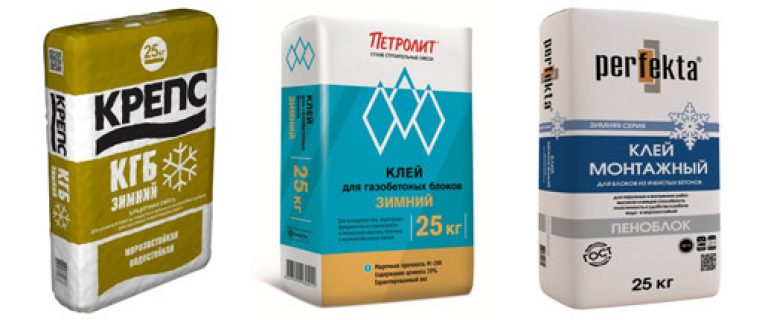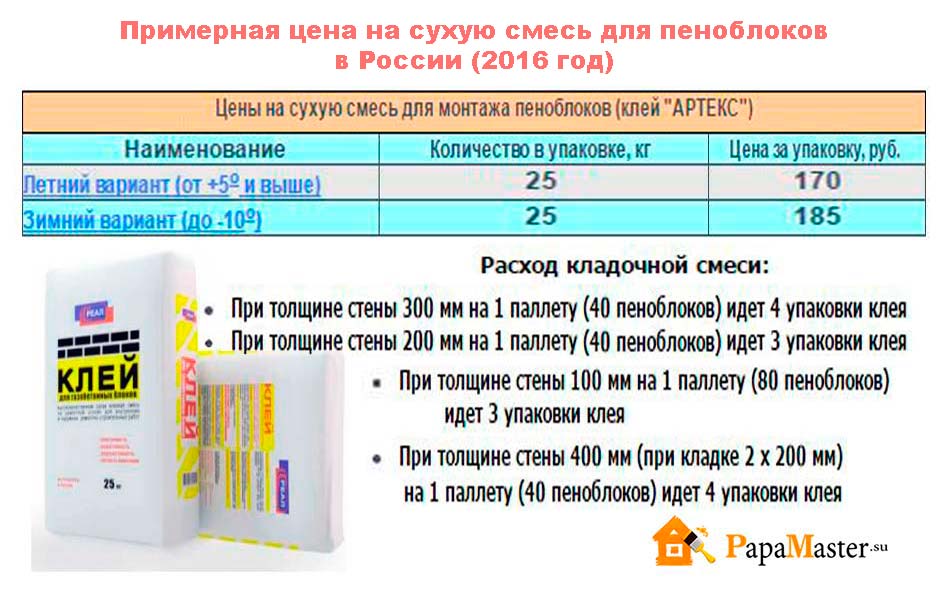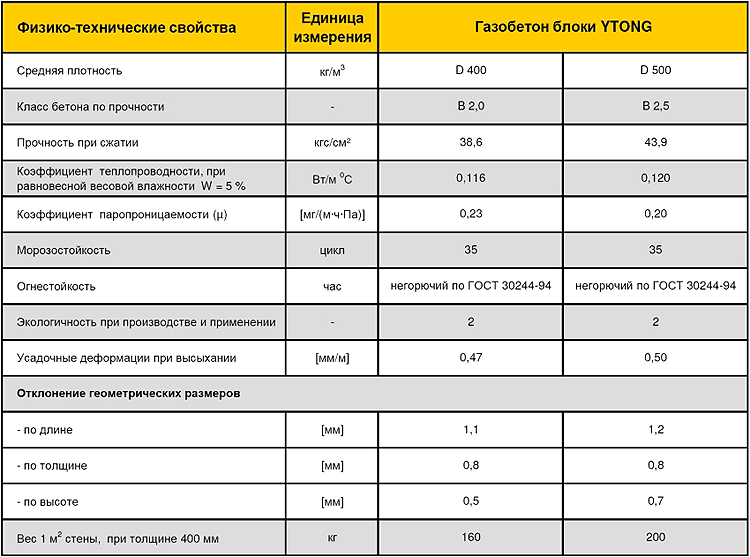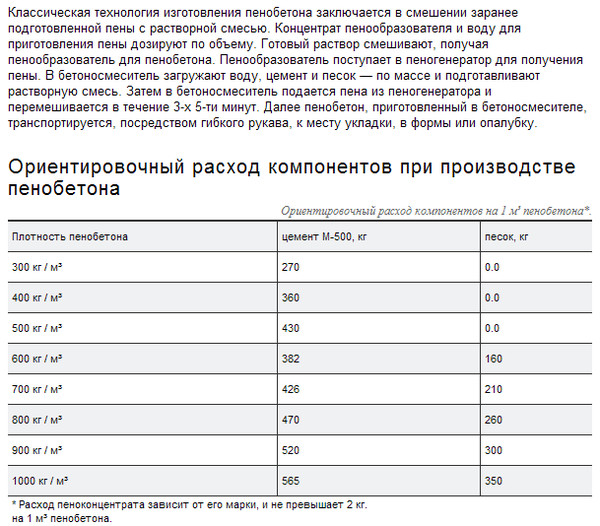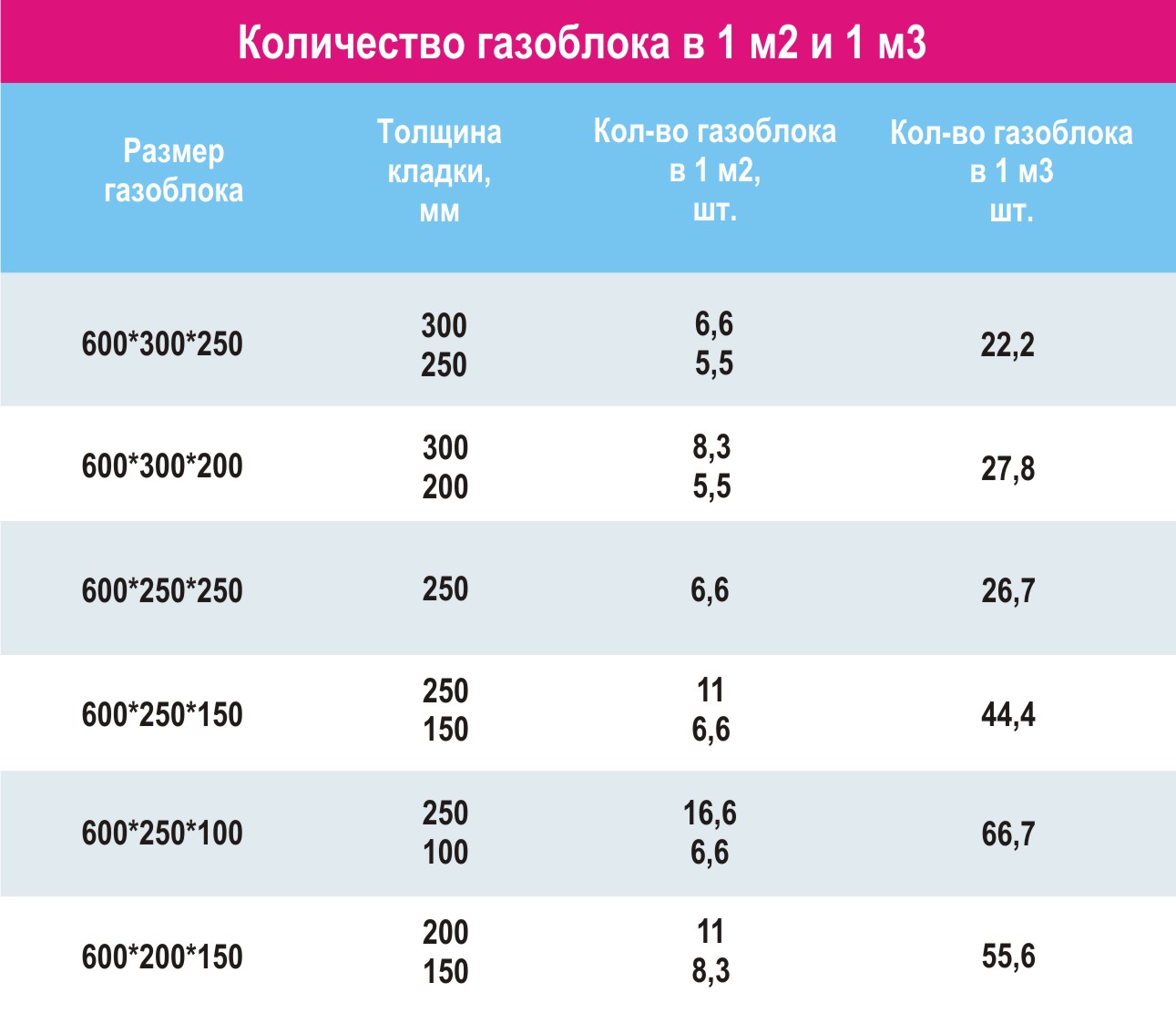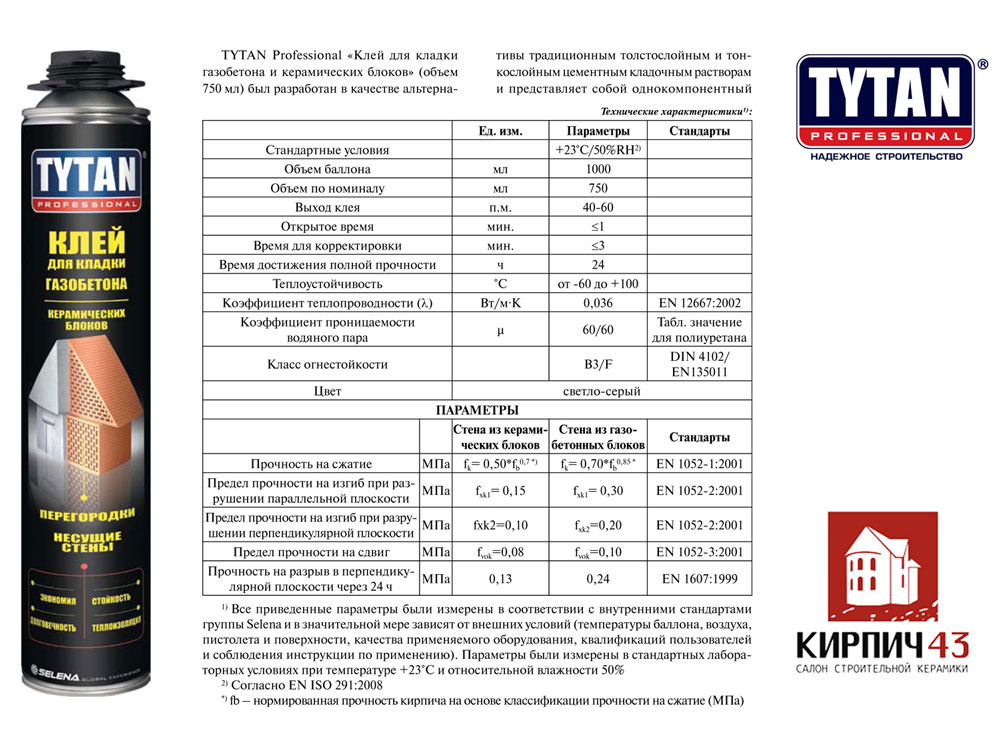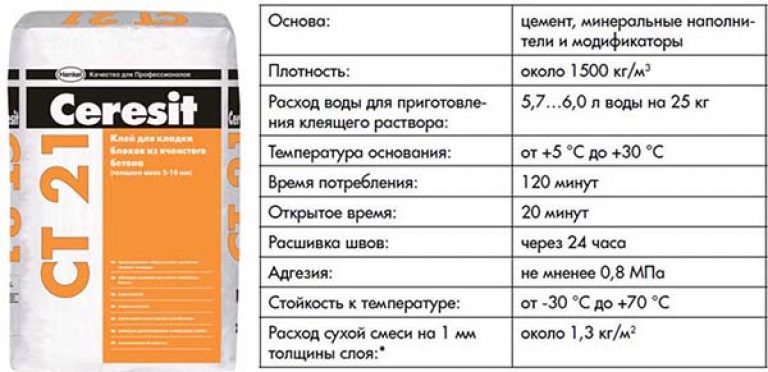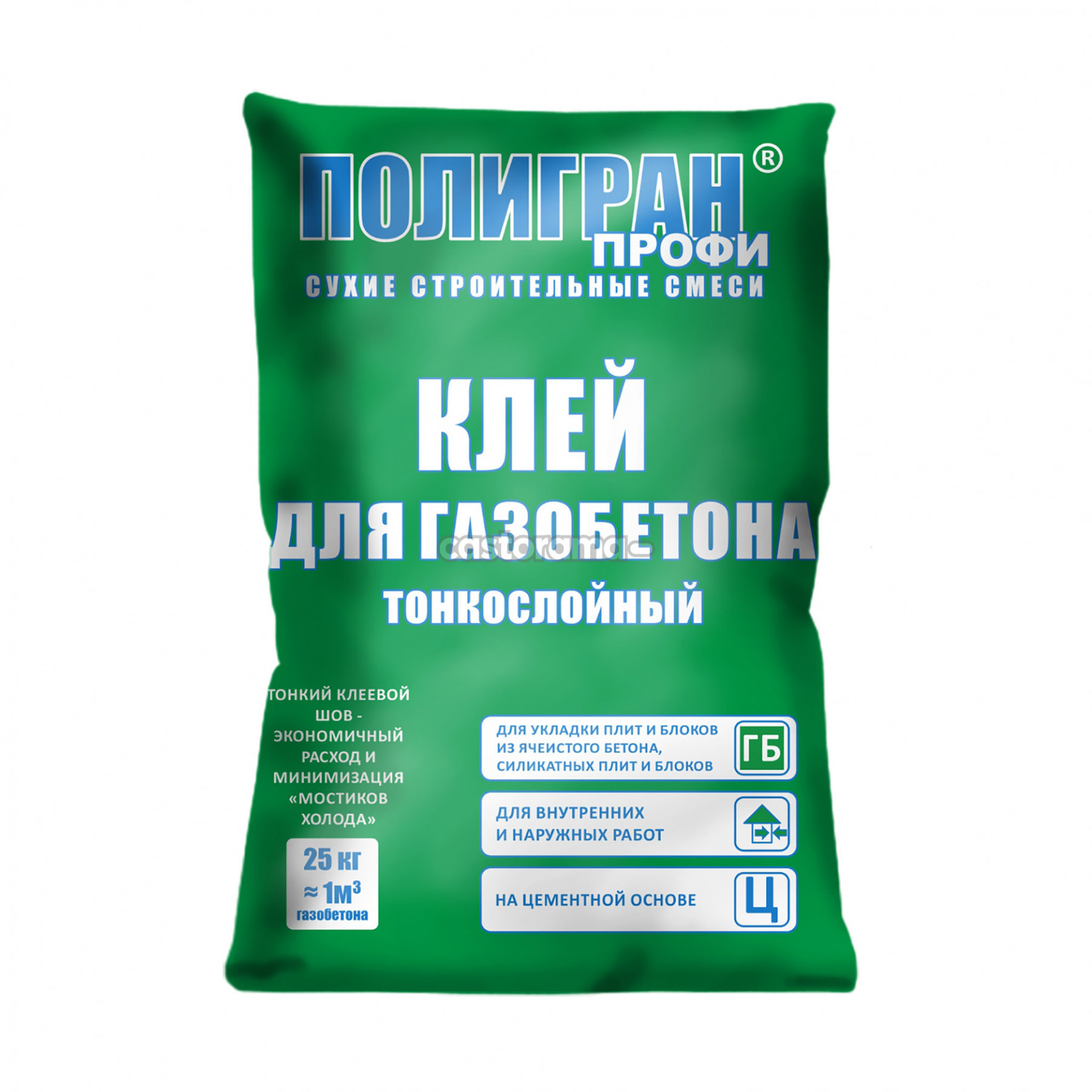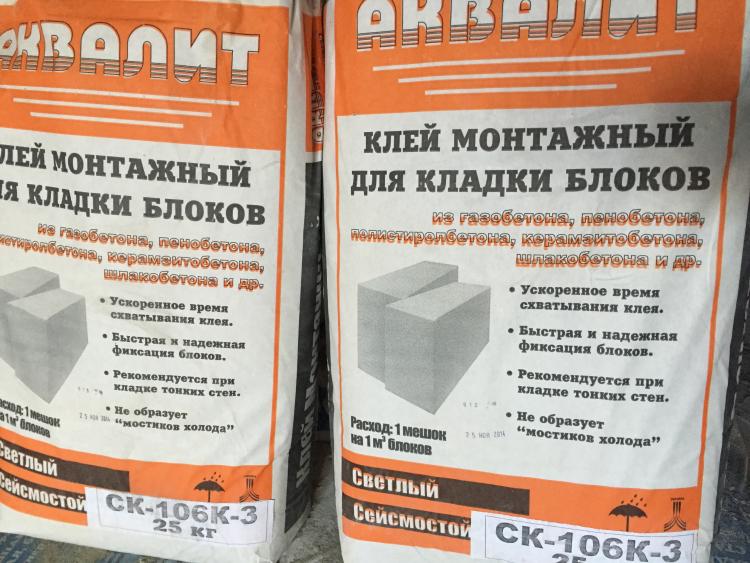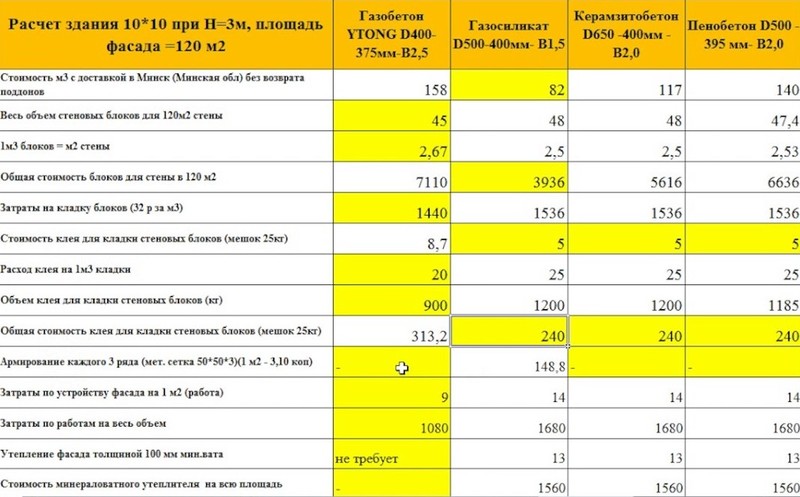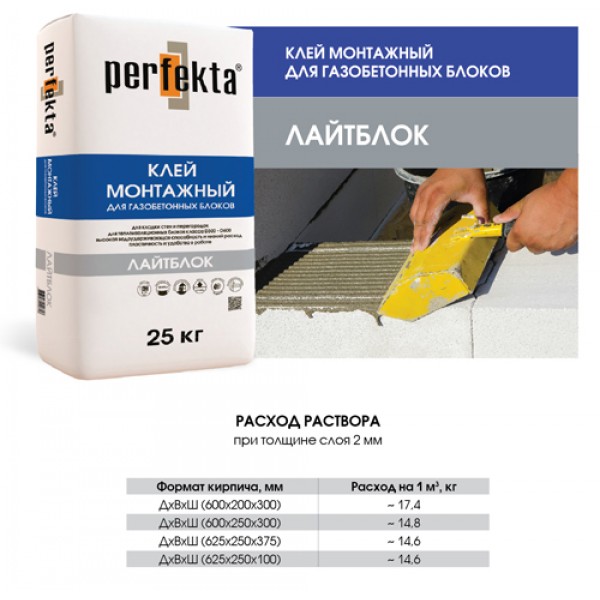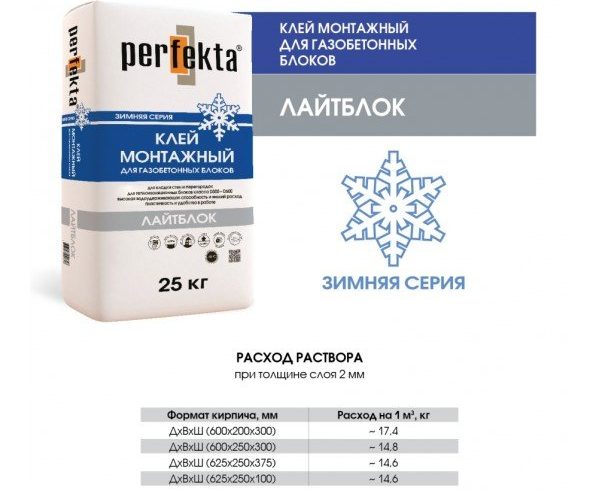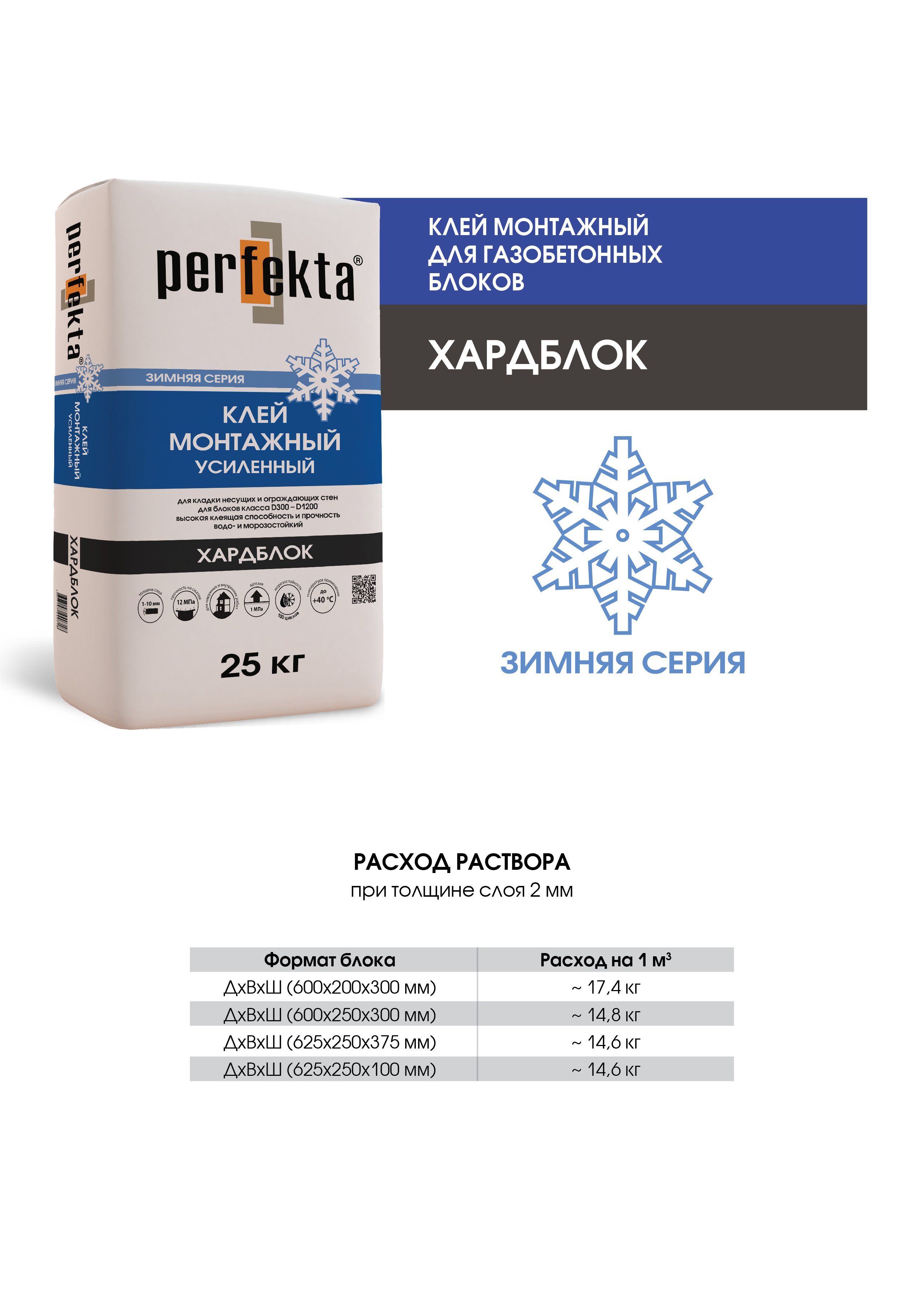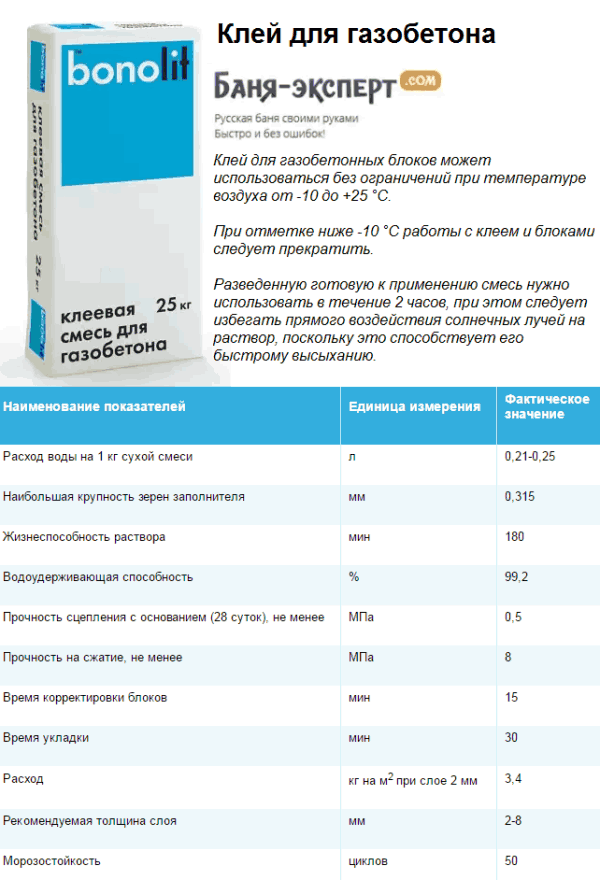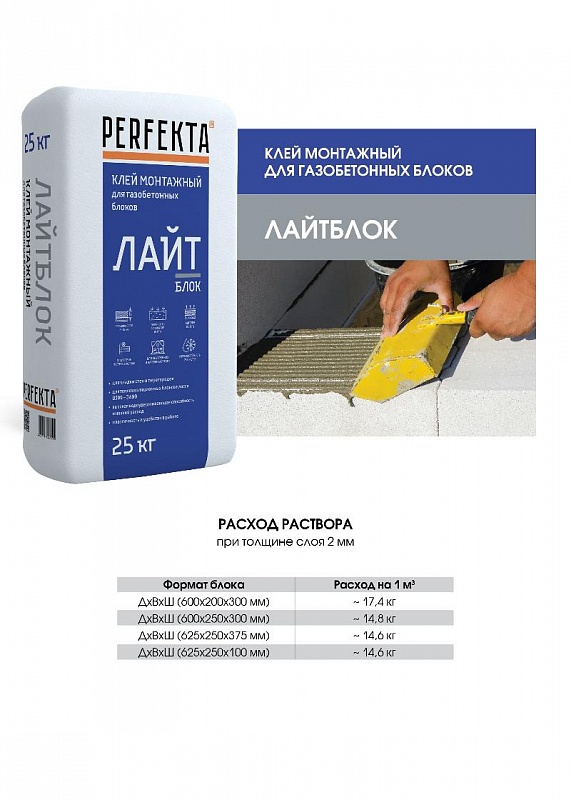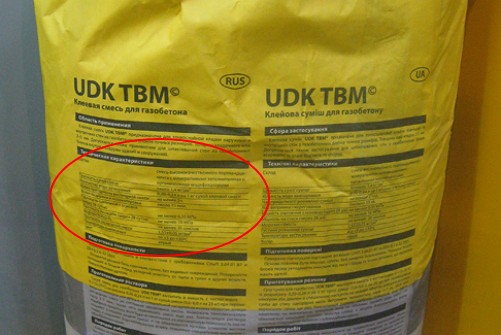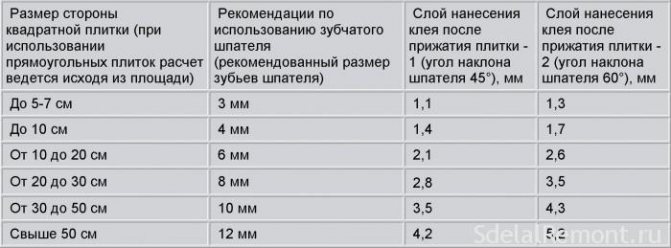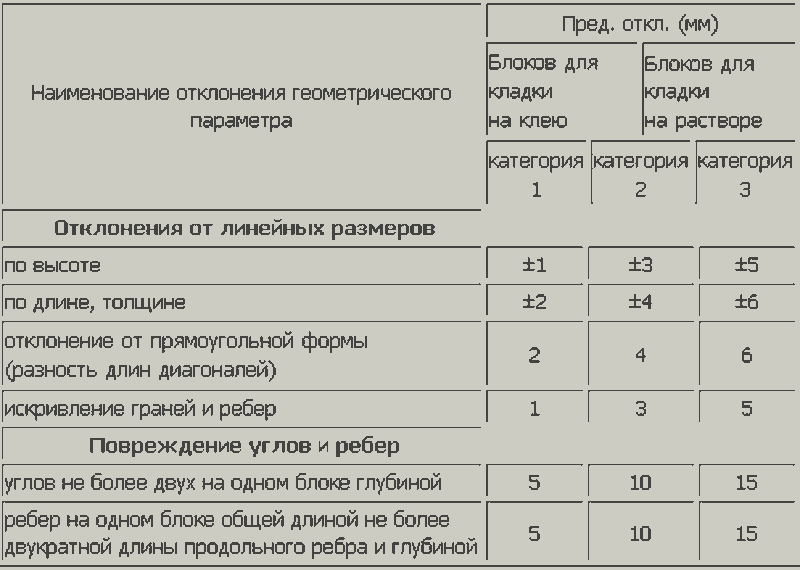Popular adhesive mixtures
When deciding which glue for gas silicate blocks to choose, it is worth studying the features of current proposals.
Aerostone is a product of the Dmitrov aerated concrete product plant. Cement-based mixture with polymer additives. The product is presented in winter and summer versions.
Adhesive for gas silicate blocks Aerostone
- Thermocube is an adhesive mixture for indoor and outdoor use, designed for thin-joint masonry of walls and partitions based on groove and non-groove gas silicate blocks. The building material is distinguished by high qualities of strength, frost resistance and plasticity. Provides economical consumption.
- Ilmax2200 - glue for masonry of porous concrete blocks, including gas silicate, aerated concrete, expanded clay concrete slabs and other wall panels. Frost resistance of the product - 75 cycles, operating temperature in the range from -30 ° C to + 70 ° C, the temperature for laying blocks varies in the range from + 5 ° C to +25 ° C. The ready-made solution is used within 4 hours.
- Ceresit is perhaps one of the most popular construction brands, a supplier of high-quality mixes for work in various categories. Ceresit CT21 glue is made on the basis of cement; mineral fillers and organic modifiers are included as additives. The product is used for thin-layer masonry of gas silicate wall blocks and other types of aerated concrete panels.
- Knauf is a gypsum-based adhesive that provides strong adhesion to the surface. The products of this manufacturer are in demand due to their competitive quality, although they are sold in an expensive segment. The environmentally friendly Knauf Perlfix adhesive mixtures are easy to apply and allow for quick alignment of blocks.
- IVSILBlock - the mixture is used for laying grooved and ordinary blocks from aerated concrete. Polymer inclusions increase adhesion, and modifying additives impart plasticity to the binder base. The position of the blocks when laying with this mortar can be adjusted within 25 minutes, which is considered a competitive advantage of the material.
- Aeroc is a product of an aerated concrete manufacturing enterprise from St. Petersburg, which occupies a leading position in the domestic market of building resources.
- Zabudova is one of the best adhesives for gas silicate blocks. The products are appreciated for their high performance in winter use at a relatively low cost. The composition perfectly manifests itself at ambient temperatures down to -15 ° C, it is easy to mix and apply, the consumption is more than economical, the seams are not susceptible to weathering.
- Unic Uniblock - the brand manufactures high-quality gas silicate blocks and mortars for masonry, the products are sold in the middle segment.
- Bonolit - a dry concentrate for gluing gas silicate deserves attention for its absolute environmental friendliness of the composition, does not have toxic impurities, and is in demand both in external and internal works.
Adhesive for gas silicate blocks Bonolit
- "Prestige" - the mixture is used for masonry of all types of porous concrete blocks, it is characterized by high frost resistance due to the composition with modifiers.
- "Pobedit" is a multicomponent cement-based adhesive with quartz sand and polymers, in composition it is completely identical to aerated concrete blocks and is able to adhere to the surface as high as possible, forming a monolithic composition.
- "EK Chemical" - a mixture intended for thick-layer masonry, suitable for work in any season. In addition to the construction of walls and partitions from blocks based on aerated concrete, the composition can be used when installing ceramic tiles and leveling wall surfaces.
Applying glue when laying
The laying of building material in the form of blocks is carried out quite quickly. This largely depends on a new tool for controlling the thickness of the adhesive. It is called a bucket trowel, aerated concrete carriage, a special container. This tool allows you to apply glue with maximum savings, which significantly reduces the cost of construction work. Special glue for gas blocks has a number of advantages over other compositions:
- small seam thickness;
- low humidity;
- constant composition of glue for aerated concrete;
- the presence of antifreeze additives;
- the remnants of the finished glue are used as a putty;
- winter products are produced for work at low temperatures;
- the product does not shrink.
The filler has a very fine fraction, due to which a high plasticity of the adhesive is achieved. It allows you to form a layer with a thickness of 2-3 mm. At the same time, the consumption of glue for aerated concrete per 1 m3 decreases by about 4 times, the degree of thermal insulation of the walls increases. Only 5.5 liters of water is needed for 1 bag of dry mix (25 kg). This protects the aerated concrete blocks from excessive moisture. The composition of the mortar always remains the same, which makes it possible to have identical material adhesion indicators on all sections of the wall. The glue does not freeze at sufficiently low temperatures due to special additives. The rest of the glue mixture for aerated concrete can be putty on various surfaces.
It is recommended to store dry mixes in a warm and dry place. When laying, aerated concrete blocks should not lie under the snow. It is better to keep the tools for work in water. A 25 kg bag is enough for 1 cube of building blocks. How to choose the right composition? If possible, run tests:
- Blocks are glued in pairs with several types of glue. After a day, the place of gluing is broken. If the seam remains intact, and the stone collapses, this is the best glue. The fracture occurred along the seam itself - the adhesive composition is of very low quality.
- Knead 1 kg of each glue and place in equal containers. Weigh each container in a day. The best adhesive will have the lightest weight.
The technology of laying aerated concrete blocks on glue is not limited only to purely adhesive compositions. In European countries, foam has been used for a long time and very actively for these purposes. The usual dry formulation is packed in 25 kg bags. From this amount, 18 liters of glue can be prepared. How much glue is consumed per 1m3? Consumption for a layer thickness of 1-3 mm will be 16-17 kg. This must be taken into account when calculating the consumption of glue per 1 m² or cubic meter. The shelf life of the finished composition is a maximum of 3 hours. You can correct the position of the blocks within 10-15 minutes.
The calculation of the glue consumption per cubic meter also depends on the size of the blocks. Usually blocks of 600x300 mm are taken. But it is better to make all calculations with some margin. You need to prepare the working mass correctly. This is done like this:
- the right amount of water is taken;
- water is poured into a container for diluting the dry mixture;
- the mixture is gradually poured into the prepared water;
- mixing is best done with a mixer for 4-5 minutes;
- take a break for 10 minutes;
- mix everything again;
- periodically stir the finished solution.
You should not prepare a lot of mortar for aerated concrete blocks, as it dries quickly. It is enough to knead the amount that goes into the laying of the gas block in half an hour. When can block walls be laid? It largely depends on various factors:
- humidity of the surrounding air;
- its temperature.
The masonry rate requires work in a dry and warm enough season. The technology of laying aerated concrete blocks provides for this for an optimal drying rate of the glue. It is not recommended to work in rain and snow, use frozen blocks for masonry.
The purchased blocks must be examined and the defective ones must be sorted. In masonry work, only products with a good and clean surface are used.One of the conditions is the acceptable level of moisture content of the material. The glue is applied in a thin layer, the building material is placed on it, the excess glue mixture is removed with a trowel or smeared on the wall surface.
Advice
When choosing a particular brand of glue, you should be guided by the following criteria.
Manufacturer's name. Very often there are insidious one-day firms that produce low-quality promotional materials that turn out to be fiction and do not bring the desired result, and sometimes harm the building. In order not to be mistaken and not to fall for the bait of scammers, it is better to trust well-known and proven brands, and also remember that a quality product cannot be cheap.
Packaging and storage conditions
When choosing a product in a warehouse, immediately pay attention to how it is stored. Increased humidity in the room, a sharp change in temperature, damage to packaging, a bag with blurry letters and a company logo - all these are clear witnesses of a poor-quality mixture.
This material is as good, subject to the rules of its storage, as it is disgusting when at least one parameter does not correspond to reality.
By weight. Never agree to purchase glue for gas silicate blocks without packaging. Nobody can give you a 100% guarantee that there are no substandard impurities.
Having decided on the brand-manufacturer of glue for gas silicate blocks, you can start calculating the material consumption. Often, all companies indicate this value on the packaging of their products, however, this information is just a reference, therefore, for each individual case, it is necessary to calculate the consumption of glue per cube of blocks individually.
The main parameter on which the amount of solution consumption per 1 m3 depends is the thickness of the layer. If this indicator is no more than 3 mm, then the amount of glue will average from 8 to 9 kg per cubic meter. With a layer thickness of 3 mm or more, the consumption of the finished mixture increases 3 times and is 24-28 kg for the same surface area.
To somehow optimize the consumption of glue, you can resort to the following technological tricks.
- Surface preparation. One of the important criteria when laying gas silicate blocks using specialized glue is perfect evenness. The smoother the blocks, the less the consumption of the building mixture will be.
- Compliance with the technology of preparation of the solution. Just take and knead the glue for laying gas silicate blocks, like dough for pies, will not work. It also has its own system: firstly, the glue powder is poured directly into the water collected in a clean container (a plastic or galvanized bucket is ideal); secondly, stirring occurs in two stages, with a short break (5-7 minutes, no more); thirdly, you should not direct a large volume of the mixture at once, since you may not have time to use it all before the moment of solidification (for most manufacturers, this time is limited to 2 hours).
- Application methods also play an important role in reducing glue consumption. So, for example, the main tool for laying the mixture is a spatula with teeth. It is better to lay gas silicate blocks 10 minutes after applying the glue, pressing firmly and knocking on the surface with a rubber hammer.
The first row of blocks is never glued. There is always a foundation under the initial "line" of the entire structure: concrete screed, screw piles, and so on. So the whole building will be much more stable and durable.
These are the main tricks that must be used in work in order to minimize the consumption of glue for gas silicate structures without compromising quality.
In order to position the blocks as accurately as possible, and between them - layers of glue, it is necessary to use mixtures designed for a specific individual case: for indoor or outdoor work, for laying gas silicate blocks at high or low temperatures.
It is also necessary to remember that the minimum period of glue hardening in a block or panel structure is 24 hours. But the best and final result is observed not earlier than the third day after installation.
Compliance with the main indicators of temperature and humidity allows the construction of a gas silicate structure using special glue quickly, easily and efficiently even for a novice builder who does not have additional skills or education
Of course, it is very important to enlist the support of professional bricklayers and experienced builders in this difficult matter, so that later you can only rejoice and enjoy the positive result of your own efforts.
For information on how to choose an adhesive for gas silicate blocks, see the next video.
Which glue for foam blocks is better
The range of mixtures on the construction market is quite large, you can simplify the task when choosing if you take into account the following recommendations:
- low price often means low quality, but the most expensive mixtures do not always meet expectations;
- materials from reliable manufacturers should be considered;
- the calculation of a sufficient amount of dry mix is done with a margin: experts advise purchasing 1 package more;
- when choosing, take into account the weather conditions, the season: if the work is planned to be carried out in winter, only frost-resistant glue should be considered as options.
Volma

Volma brand glue.
This variety is suitable for laying silicate, gas and foam blocks. The average cost of a package (25 kg) is 177 rubles. This composition can be used indoors and outdoors.
Its main advantage is its relatively low consumption (1.4 kg per 1 m²). The position of the blocks must be quickly corrected - no more than 10 minutes are allotted for this.
This glue can be used to create a seam with a thickness of 2 to 5 mm. When mixing the dry mixture, take into account the ratio of this material and water, respectively: 1 kg and 0.21-0.23 liters. Strength bending is 5 MPa... Recommended temperature range: + 5 ... + 30 ° С. Frost resistance index - F35. The finished solution retains its properties for 90 minutes at a temperature of + 15 ° C.
Adhesive foam titanium
Available in the form of an aerosol (balloon) Volume - 870 ml. Average price - 480 rubles. This type is intended for laying gas and foam blocks. It is a polyurethane based adhesive. It is characterized by high adhesion and lasts a long time. The advantage is that there is no waste, since the mixture is applied with a construction gun in an amount sufficient to secure the blocks. The adhesive can be used at low temperatures.

Titanium foam adhesive is available in aerosol form.
It is important to prepare the surface before applying the Titanium Polyurethane Adhesive. Otherwise, adhesion will decrease.
To be able to work with this mixture, the balloon should be kept warm: it is immersed in warm water for a while or left in a heated room for 1 day. Then the balloon is shaken several times. It can only be opened after installation in the gun. Outside, the foam layer is protected with a thin layer of cement mortar.
Knauf
This type of mixture can be used for stacking blocks of different types and for foam blocks as well. Its average price is 160 rubles. pf packaging (25 kg). This composition contains polymer additives that increase the strength of the material. The advantage is the low consumption of 18 kg. The amount of water for preparing a mixture using 1 kg of dry material is no more than 0.2 liters.
For working with adhesive, it is recommended to use a float, usually a trowel. The compressive strength of the material is 2.5 MPa. This type of mixture is used to create joints of substantial thickness - up to 12 mm.
Ivsil Block

Ivsil Block is a versatile material.
This is a universal type of material, suitable for fixing blocks of different types and foam blocks as well. The average cost of a 25 kg package is 215 rubles. The composition includes cement, polymer and water-retaining additives, fine sand. The material is suitable for indoor and outdoor use. It can be used to create a 2 mm seam.
This reduces the risk of freezing of the structure through the joints. Low material consumption is also an advantage. In addition, it is possible to work with the ready-made mixture much longer than with other types of solutions - up to 4 hours.
Tile adhesive
If it was not possible to choose the most suitable version of the mixture for working in harsh conditions (in the cold), it is permissible to purchase tile adhesive that can withstand exposure to low temperatures. However, this option can only be used if the blocks are sufficiently flat. The permissible deviation is no more than 1.5 mm in height. Recommended for masonry - up to 100 mm on the longest side. Choose tile adhesive for the installation of such products if you have experience in performing construction work.
Preparation of working solution
Before starting work, you need to study the instructions on the package and clearly adhere not only to the ratio of the adhesive composition to the volume of liquid, but also to the appropriate temperature regime.
There are general requirements for work:
- a container must be prepared in advance, where the solution will be mixed, and a drill with a construction mixer;
- the ratio of dry concentrate to water, as a rule, is 1 to 0.22 (about 220 ml of water is needed per 1 kg of powder);
- the water temperature must comply with the instructions, but not lower than 15-20 degrees;
- the mixed solution must be homogeneous.
To obtain high quality adhesive components, it is recommended to mix everything until smooth, leave the mixture for 10-15 minutes, and then mix thoroughly with a mixer again. Use the ready-made mixture within the next 3-4 hours, unless otherwise indicated in the instructions for use. You cannot add water to a ready-made solution.
Manufacturers
A wide range of adhesives for foam block masonry often confuses finishers. How to choose the right composition? How not to make a mistake when purchasing a mixture? What should the foam blocks be attached to?
First, remember a few simple rules:
avaricious pays twice - don't try to chase cheapness
buy goods from a well-known manufacturer with a good reputation in the building mixtures market
when making a purchase decision, take into account the season and temperature conditions under which the work will be carried out - it is advisable to purchase a frost-resistant composition for the winter
And now let's get acquainted with the creators of the most popular adhesives that have earned positive reviews from professionals around the world.
Volma
Volma is one of the leaders in the construction market, which has won the recognition of consumers in Russia and abroad. The adhesive of this brand consists of selected cement, fine sand, filler and pigments of the highest quality. This compound is used for joints of 2-5 mm.
This glue is used by finishers when assembling slabs from aerated concrete blocks.
It is sold in 25 kg paper bags.
Titanium
When the glue-foam from the well-known brand "Titan" first appeared on the market, most professionals were skeptical about this new product. However, after the first applications, doubts about the quality and exceptional consumer indicators of the composition completely disappeared.
Titan products replace cement mortars, are very easy to use - you just need to apply a strip of composition to the blocks and fix them. At the same time, construction is progressing quite quickly, and the finished structure is durable and stable.
When applying foam glue, it is worth adhering to several rules:
- the surface of the foam blocks should only be flat;
- the layer of glue is applied in accordance with the instructions, do not exceed the thickness recommended by the manufacturer;
- the foam shrinks under the influence of direct ultraviolet rays, therefore, the outside of the joints should be sealed with cement;
- glue-foam is used only for the second layer of foam blocks.The first one should be applied to a cement-sand mortar, otherwise, under heavy weight, the glue will quickly deform.
Available in 750 ml cylinders.
Knauf
Knauf Perlfix glue provides a high level of adhesion thanks to a plaster base and special polymer additives.
The use of glue does not require preliminary installation of the frame, the work is carried out quickly, and the structure is stable.
The undoubted advantage of the composition is its environmental safety, therefore it is widely used in private housing construction.
The glue is quite economically consumed - for processing a coating of 1 sq. m. only 5 kg of composition will be required.
It is sold in kraft bags with packaging of 30 kg.
IVSIL Block
The glue of this manufacturer has been widely used when laying aerated concrete and aerated concrete blocks. The mixture is a dry powdery composition based on cement with a small content of additives that increase the adhesion of the surface.
It is used for joints from 2 mm, with this glue consumption will be in the range of 3 kg per m2.
When using glue, the position of the foam blocks can be adjusted within 15 minutes from the moment of fixation.
It is sold in bags of 25 kg.
Osnovit Selform T112
It is a frost-resistant compound intended for use in winter. The formed joints easily withstand up to 75 freeze-thaw cycles - this figure is one of the highest among the winter types of foam concrete glue.
The adhesive mixture is characterized by a fine filler fraction, due to which it is used to obtain thin joints from 1 mm. This leads to a decrease in the total consumption of the composition - only 1.6 kg of dry glue is required for pasting 1 m2 of foam blocks.
The advantage of the glue is its quick adhesion - the composition hardens after 2 hours, so that construction work can be carried out quite quickly.
It is sold in bags of 20 kg.
Among Russian manufacturers, the Rusean brand is also distinguished as having high quality and cost-effective products.
Consumption of glue for foam blocks per 1m2 / m3
The consumption rate of glue per 1 m2 is approximately 1.5–1.6 kg of dry powder with an applied thickness of 1 mm, therefore, 15–30 kg will be consumed per 1 m³. As we can see, the numbers are approximate, since it is almost impossible to name the exact figure of how much glue is needed per cube of the foam block. But we will allow ourselves to average the indicators - and name a certain weight - 25 kg. This is the weight that one bag of adhesive has. Knowing this, it will be easy for mothers to calculate how much glue is needed for the construction of masonry. And for more convenience, we present to your attention the list below:
- for 1 m² - ≈1.5 kg;
- for 1 m³ - ≈25 kg (one bag).
This is the consumption of glue for foam blocks 20 × 30x60 / 40 × 30x60 - the average figure is 25 kg. But in practice, it can happen in completely different ways. It also happens that about 1.5 bags are consumed per 1 m³. The fact is that this is influenced by certain factors, which we will now list as a list:
- use of the tool. Here improvisation will be out of place - the tools must be used those that are intended for our purposes;
- condition of materials for masonry. Their surface should be even and smooth, but it happens that their condition cannot be called ideal;
- weather. In the cold season, it is better to refrain from such work, especially if you are not a professional in this matter;
- qualification of the master. This point follows from the previous one. Naturally, in order to carry out such work properly, certain knowledge and experience in this area is required.
The method of applying and preparing the adhesive composition also affects its consumption. Therefore, when cooking, it is necessary to use only a drill mixer (kneading by hand is a thankless job), and dilute with water to a homogeneous consistency.The composition should not be very dry and thick, but not too sparse and liquid, since - in either case - it will not perform the functions assigned to it.
I have heard the opinion that the composition can be diluted with sand in proportions of almost 1: 1. Allegedly, this will increase the strength and, most importantly, it is cheaper, because less dry powder will be used.
So, this opinion is erroneous. It is impossible to mix in sand (or something else). Otherwise, the composition will turn out to be heterogeneous, the layer is uneven and, as a result, an uneven wall. And this should not be allowed, even if you are pursuing such noble goals as economy or increasing strength. Moreover, there will be no savings here. To even out the layer, you will have to make it thicker, because, as they say, that's what it will do.
The composition should be applied to the surface of the block in an even, thin layer. The thickness is usually up to 3 mm. Naturally, no one specifically measures this indicator if it is not laboratory research. In this business, as in any other, you need the skill that comes with practice. But this business cannot be called super-complicated. Having laid 5-10 elements of the future structure, you will already be laying them, as if you have been doing this all your life.
Keep in mind that no matter how accurate your calculations may seem to you, the material must be purchased with a small margin. This applies not only to glue, but also to the masonry elements themselves. If you have small leftovers, this is not critical. In any case, they may be needed another time, but if something is suddenly missing, it is much worse, especially if you need to complete the construction within a limited time frame.
So we figured out how much glue is needed for one cube of the foam block. We can draw an analogy with aerated concrete and gas silicate. After all, all of the listed building materials belong to the same detachment and they fit according to the same principle.
Types of mixtures for aerated concrete masonry and application features
There are seasonal varieties of dry adhesive concentrates on the market based on white and gray Portland cement, as well as compositions in the format of foam in cylinders:
- The white version of the building resource - summer glue for gas silicate - provides for use in the warm season. The composition owes this color to the base of white Portland cement. The attractive appearance of the fastening solution makes it in demand in interior work, which makes it possible to save on finishing.
- Gray glue is considered winter glue, although it is a versatile option for aerated concrete masonry in any season. The composition has anti-freeze additives and is suitable for use in a wide range of temperatures down to -10 ° C.
According to experts, for the maximum effect, the frost-resistant mortar is recommended to be used at temperature ranges from + 5 ° C to -15 ° C, this guarantees the absence of errors and cracks in the seams.
The process of drying out the masonry at an elevated environment temperature regime is fraught with the risk of microcracks in the bonding layer, and as a result, the thermal conductivity characteristics of aerated concrete deteriorate.
Aerated concrete blocks are known to be inert to changes in ambient temperature. In this case, the correct technology for applying the adhesive plays an important role, while strictly following the manufacturer's instructions.
What is recommended when working with a winter composition for laying gas silicate:
- a heated room should be used for storing bags with dry concentrate;
- preparation of the solution is carried out in a warm room, the water temperature for diluting the dry mixture should be at least + 20 ° C;
- working solution temperature - not lower than + 10 ° C;
- the ready-made solution is used for its intended purpose within half an hour.
Freezing of moisture is fraught with a deterioration in the quality of the seam, therefore, during winter work, the aerated concrete masonry should be covered with a tarpaulin.
Foam adhesive for gas silicate is an innovative solution in this segment.The building resources market offers an adhesive composition for porous concrete blocks in the form of foam in cylinders, for which a special device is used in the form of a construction gun.
The composition of the glue
 It is necessary to choose glue for aerated concrete very carefully, depending on the volume of the masonry to be performed and the time of year in which the construction is supposed to be carried out.
It is necessary to choose glue for aerated concrete very carefully, depending on the volume of the masonry to be performed and the time of year in which the construction is supposed to be carried out.
Currently, the market of modern building materials is ready to offer domestic and foreign adhesive mixtures that can be used exclusively in the warm season.
As well as universal formulations, ideal for construction work, both in summer and with light frosts.
Note: Adhesive for aerated concrete blocks is mainly sold in packs of 25 kg. Some firms produce glue in 20 kg bags.
As a rule, professional builders use universal mixtures, which include:
- a binder represented by Portland cement;
- fine-grained and high-quality sand cleaned from impurities;
- modifier additives that can prevent cracking of the seams and allow you to retain moisture;
- plastic polymer additives aimed at improving adhesion in low-temperature conditions (for the winter version).
Of course, universal (winter) adhesives, due to their high quality characteristics and breadth of application, are somewhat more expensive than seasonal adhesives.
Winter glue
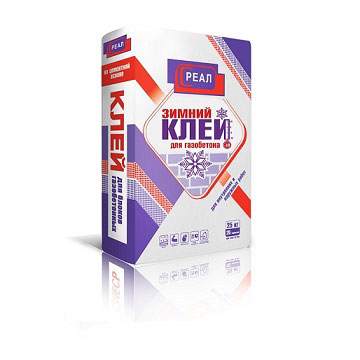 Frost-resistant or universal adhesives are sold packaged in bags and visually noticeably differ from conventional mixtures in their characteristic gray color.
Frost-resistant or universal adhesives are sold packaged in bags and visually noticeably differ from conventional mixtures in their characteristic gray color.
The use of such glue is not limited exclusively to external masonry work, therefore, a universal composition is also in demand when erecting internal partitions or walls.
If necessary, such an adhesive can also be used to putty work and high-quality leveling of wall surfaces.
A distinctive feature is the ability to harden without shrinkage.
In order to preserve the adhesive properties of the adhesive, manufacturers have developed a number of recommendations, including the need to store dry mixtures in heated and non-humid rooms and the use of water at a temperature of 50-60 ° C to prepare the adhesive solution.
Before laying, the surface of aerated concrete blocks must be freed from ice or snow mass using a stream of warm air from a building hair dryer. All the nuances are described in detail in the article about laying aerated concrete blocks in winter
It is important to remember that diluted winter glue mixtures cannot be stored for a long time and should be used after mixing as soon as possible.
Adhesive dry mixes with additives that allow for construction masonry work in winter:
- Polimin;
- Ceresit;
- Baumit;
- UDK-TBM;
- Kreisel;
- Aeroc.
Foam glue
 In addition to traditional adhesives, represented by thin-seam or thin-layer dry masonry mixtures, recently such modern materials as aerosol polyurethane foam adhesives, sold in special balloon tubes, have been actively used.
In addition to traditional adhesives, represented by thin-seam or thin-layer dry masonry mixtures, recently such modern materials as aerosol polyurethane foam adhesives, sold in special balloon tubes, have been actively used.
Foam adhesives have the following characteristics:
- high rates of efficiency;
- improved performance;
- the highest level of adhesion, which is achieved a couple of hours after use;
- the minimum thickness of the seams allows you to completely eliminate the formation of cold bridges;
- construction work can be carried out in winter, when the temperature is up to minus 8-10 ° C.
However, according to experienced builders, the use of such an adhesive does not always justify itself, and in some cases, when foaming seams, slight fragility of the applied mass may be noted. In addition, foam at the moment is much more expensive than glue. When building a two-story country house, it is better to save money and choose glue.In addition, this will not affect the quality of the walls.
Adhesives-foam in cylinders on a polyurethane base in the middle price category:
- Ceresit SM-115;
- LimFix;
- TYTAN-Professional;
- Bonolit "Formula of heat".

